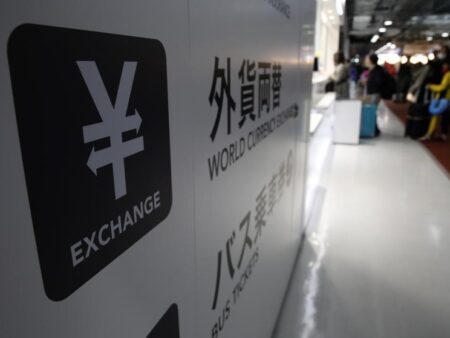By Noe Torres and Rodrigo Campos
MEXICO CITY/NEW YORK (Reuters) -The Mexican peso touched its weakest against the U.S. dollar in nearly two years before paring much of the losses back, as concerns the U.S. economy could be headed for a recession added to recent peso weakness as a popular global trade unwinds.
The Mexican currency was trading at 19.37 pesos per greenback, down about 1.1% from the Friday close. The peso’s overnight fall in foreign operations was of as much as 4.4%, when the currency surpassed the psychological barrier of 20 pesos per dollar, a level not seen since October 2022.
The peso was dragged down by a wave of liquidations in global markets, particularly in Asia. The Japanese yen rose to a seven-month high against the dollar as traders unwound their “carry trade” positions, one of the factors that had sustained the peso’s strength until recently.
The trade involves funding in low-interest currencies like the yen while investing in higher yielding currencies like the peso, to pocket the yield difference.
“As in any domino effect where there is panic, everything moves towards safe-haven assets and leaves assets considered risky, such as the Mexican peso,” said Gabriela Siller, director of analysis at local firm Banco Base.
Down about 1% Monday, the Mexican currency has accumulated losses of 4% against the dollar since the close on Wednesday. The selloff was triggered by the release of data last Thursday showing U.S. manufacturing activity fell to its lowest level in eight months.
“There are simply too many uncertainties on both the US and Mexican sides,” said Commerzbank (ETR:) FX analyst Michael Pfister in a Monday note, citing political uncertainty on both sides of that border as well as the possibility of a rate cut this week in Mexico even as inflation remains a concern.
“We could imagine that the peso could benefit somewhat in the coming weeks and recoup some of last week’s losses,” he added, but until early next year “we see worse times ahead.”

A weak U.S. employment market report on Friday added to the outlook of a slowing U.S. economy, as the unemployment rate jumped to near a three-year high of 4.3% in July.
Mexico is highly sensitive to economic developments in the U.S., its top trading partner and the destination for more than 80% of its exports.

















